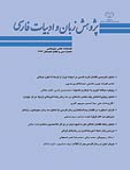رویکرد دوگانه انوری به عرفان و تصوف
محورهای موضوعی : پژوهشهای ادبیات کلاسیک ایرانمحمدحسین کرمی 1 * , ناهید دهقانی 2
1 -
2 -
کلید واژه: عرفان انوري سبک بینابین تصوف شعر قرن ششم,
چکیده مقاله :
در سراسر تاريخ ادبيات فارسي، کمتر شاعری را می توان یافت که به اندازة انوری دچار تناقض گویی بوده باشد. روشن ترین نمونة تناقض گویی های این شاعر در رویکرد دوگانه وی به تصوف دیده می شود. درونماية اشعار انوري در قصايد و مقطعات، با غزليات و رباعيات تفاوت زيادي دارد؛ همان شاعري كه در قصايد و مقطعات به مدحگويي و هجوكردن پرداخته، در غزليات و برخي از رباعيات، چهرهاي عارفانه از خود نشان داده و دم از قلندرصفتي زده است. تناقضگوييهای فراوان انوری به ویژه در زمینة تصوف موجب شده است، خوانندة اشعار این شاعر نتواند دربارة شخصيت و نيز اشعار او داوري دقيقي داشته باشد. در مقالة پیش رو، با رویکردی تحلیلی- توصیفی، ديدگاههای متناقض انوري درباره تصوف و ریشه این دوگانگی ها بررسی شده است. به نظر می رسد، دورة شاعری انوری بیش از هر عامل دیگری در ایجاد این دوگانگی ها تأثیرگذار بوده است؛ معمولاً در آثاري كه به سبك بينابين يا سبك دورة گذار نوشته شده اند، گونهاي آشفتگي سبكي ديده ميشود. این دوگانگی ها نه تنها در اشعار انوری، بلکه در اشعار دیگر شاعران سده ششم نیز کمابیش وجود دارد؛ بر این اساس، نميتوان نفوذ مضامين صوفیانه را در اشعار انوري، لزوماً گواهی بر گرايش وي به تصوف دانست.
In the whole Persian literature history, you cannot find many poets who contradict themselves as much as Anvari does. The most obvious example of this poet’s self-contradiction is noticeable in his dual approach to mysticism. The themes of Anvari′s poems in odes, Moghattaat is different from that of Sonnets and quatrain (a poem consisting of four hemistiches, rube). The poet, who developed eulogy and satire in odes and Moghattaat, also developed a mystic appearance in sonnets and quatrain. Anvari’s numerous self-contraditions especially regarding mysticism have caused the readers of his poems not being able to make a certain and precise judgment about his character and his poems. In this article, using a descriptive-analytical approach, Anvari’s contradictory views on mysticism and the origin of this duality are investigated. It seems that, poetic period in Anvari’s time, more than any other factor, had an impact on the creation of these contradictions. Usually, in works in middle style or the style of transition period, such chaos is noticeable. These contradictions are found not only in Anvari’s poems, but also more and less in the poems of other 6th –century poets. Based on this, penetration of mystic themes in Anvari’s poems can not necessarily be considered as a proof of his tendency towards mysticism.

